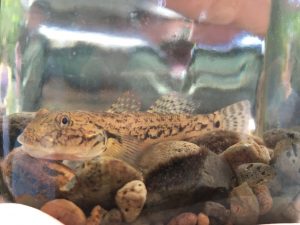
‘O’opu nakea (Awaous stamineus) is an important cultural resource for Indigenous Hawaiians. All five Hawaiian gobies exhibit amphidromous life cycles.
An amphidromous fish is a type of diadromous fish which migrates between fresh and saltwater. Unlike anadromous and catadromous fish, which migrate explicitly for the purposes of breeding, amphidromous fish migrate for other purposes. A typical cycle of amphidromy includes eggs hatching in freshwater or estuaries, larvae drifting out into the open ocean to feed and grow, juveniles returning to freshwater to feed and grow, and adults reproducing in freshwater. Gobies, such as those found on volcanic islands in the Pacific, exhibit an amphidromous life cycle.
For more information, please see:
And, check out the “CAN YOU SAY ANADROMOUS, CATADROMOUS, AMPHIDROMOUS, OCEANODROMOUS, OR POTAMODROMOUS?” post on The Fisheries Blog!
